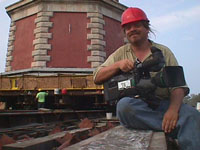From: Richard W. Adkins, WRAL-TV, Raleigh, NC
Television News Photographers are a peculiar breed. Often they are portrayed in movies or TV shows as blue jeans and t-shirt wearing college dropouts with a bizarre need to see dead bodies. Or sometimes Hollywood likes to make them out to be mind-numb shooters who don’t know news until an overdressed reporter tells them what to shoot.

Richard Adkins on Hatteras Island, NC shooting a documentary on the Cape Hatteras Lighthouse entirely in HDTV. Photo courtesy: Richard W. Adkins
But in reality most Television News Photographers are artists. And they are about to get a larger canvas, brighter colors and finer brushes with which to paint.
“It’s incredible.” WRAL Documentary Photographer Jay Jennings is talking about High Definition Television, better known as HDTV. “I find myself shooting stuff that has a lot of intricacies to it. I was looking for mossy bark on a tree, a rock with a lot of grit and detail to it, or putting a lot of sand on the beach in the shot.”
HDTV is a new format in digital television that offers photographers, and ultimately viewers, higher resolution, brighter colors and a wider screen. It’s a format that lends itself to showing off great photography. “I find myself doing that a lot, finding a lot of stuff that would really look cool! You know, nothing wrong with that!” Jennings says with a grin.
Jennings has just completed his first documentary shot, edited and aired in HDTV format. The subject? The Cape Hatteras Lighthouse on the Outer Banks of North Carolina. For Jennings, the topic presented his first HDTV challenge. “The lighthouse is up and down, the HD sets go side to side.” Jennings says while he laughs. He can laugh about it now, but the 16×9 aspect ratio of HDTV versus the current 4×3 aspect ratio was intimidating until he looked through the viewfinder at the lighthouse. “It only really presented itself as a problem shooting stand-ups. We had to position the reporter just right to keep the lighthouse in frame.”
Once Jennings was comfortable with the wider format he could concentrate on other aspects of his photography, like the subtle colors and sharp details. “I think you get a lot more differences in colors, I think you can see that in things like flowers.” Jennings says. HDTV offers more than 2 million pixels (the little dots on the screen that make up the picture) on the TV screen; current TV has about 300,000 pixels.
“People are seeing stuff that they hadn’t seen before on TV.” Jennings says about the new format. “Now (looking at TV) is like looking through a window.”
But it’s not as easy as looking through a window. To get the HDTV image from the field to the family room Jennings had to have a lot of help. “It was as coordinated as a team effort between engineering and news as we’ve ever had here. Engineering was making miracles happen everyday,” Jennings says about the technical aspects of project. HDTV is so new that there is little equipment available and incompatibility between components is a major factor. “It was incredible to know we were going out in the field and shooting a documentary in HD and not knowing how we were going to edit it.”
Jennings wound up dumping his Sony HDCAM video into an AVID computer editing system, and then recording the final product on D5. But a new digital routing system wasn’t quite ready for Jennings, and he had to go through some extraordinary measures to get the final product on tape. Jennings seems to love to tell this story: “We got a hundred and fifty foot pair of audio cables, plugged them into the mixer on the Avid, ran them down the stairwell, through video tape, through master control, to the D5 machine we were using to record this thing.”
Now the product was on tape in HDTV format, and a version had to be produced to air on conventional TV as well. Jennings says that was the final step “The D5 machine provided us with the letterbox output to dub to NTSC.”
Jennings chose to use a “letterbox” picture to air his documentary on conventional TV; that means the actual picture kept it’s 16×9 aspect ratio and viewers at home had a black space at the top and bottom of their 4×3 TV screens. But during the transition from the current analog TV format to the new HDTV format not all News photographers will have that option.
4,3,2,1, Liftoff… The flight of Space Shuttle Endeavor not only found John Glenn making history, but News Photographer Mark Copeland too.
Copeland shot much of WRAL’s HDTV coverage of the shuttle launch, as well as a news series about the historic mission. “The best sound, the best picture quality, the best way to share that experience with people was through HDTV.” says Copeland.
While much of what he shot would air in a national HDTV production, Copeland’s HDCAM video would not be “letterboxed” for his news stories airing on conventional television. Instead the sides of the 16×9 picture would be cut off on viewers 4×3 TV sets.
“More people were going to see the 4×3 than the 16×9 version and I had to weigh that in there.” Says Copeland. “I made the shots well framed in 4×3 and they seemed to flow in the 16×9 too.” That’s an issue a lot of News Photographers will have to face until a complete conversion is made to HDTV. “I was in the Smithsonian Museum shooting the Wright B flyer for a stand-up, and in 16×9 it was wingtip to wingtip and of course it was not in 4×3, but it seemed to work OK.” Copeland said.
Both Copeland And Jennings agree that most News Photographers will not have to change their style to shoot HDTV, but a little fine tuning will be in order. “You have to slow the edit pace down.” Says Jennings. “You have to give viewers the chance to let their eyes wander across the wider screen. There is so much more visual information.”
Copeland adds that handheld camera work will need to be tamed. “If it’s two people sitting on edges of desk and you’re as wide as you can go floating back and forth between interviews that fine. If you’re shooting “Cops” style and you’re running with a police officer running somebody down and a lot of traffic and everything, then it’s too much detail there and it might make you a little queasy.”
Jennings has one word of advice for News Photographers as they hit the street with this new format: “Simplify. Simplify your sequences. Simply your editing. Instead of a 10 second, six shot sequence… let it breath. Use two shots, and make them two really good shots. Go back to real basics.”
